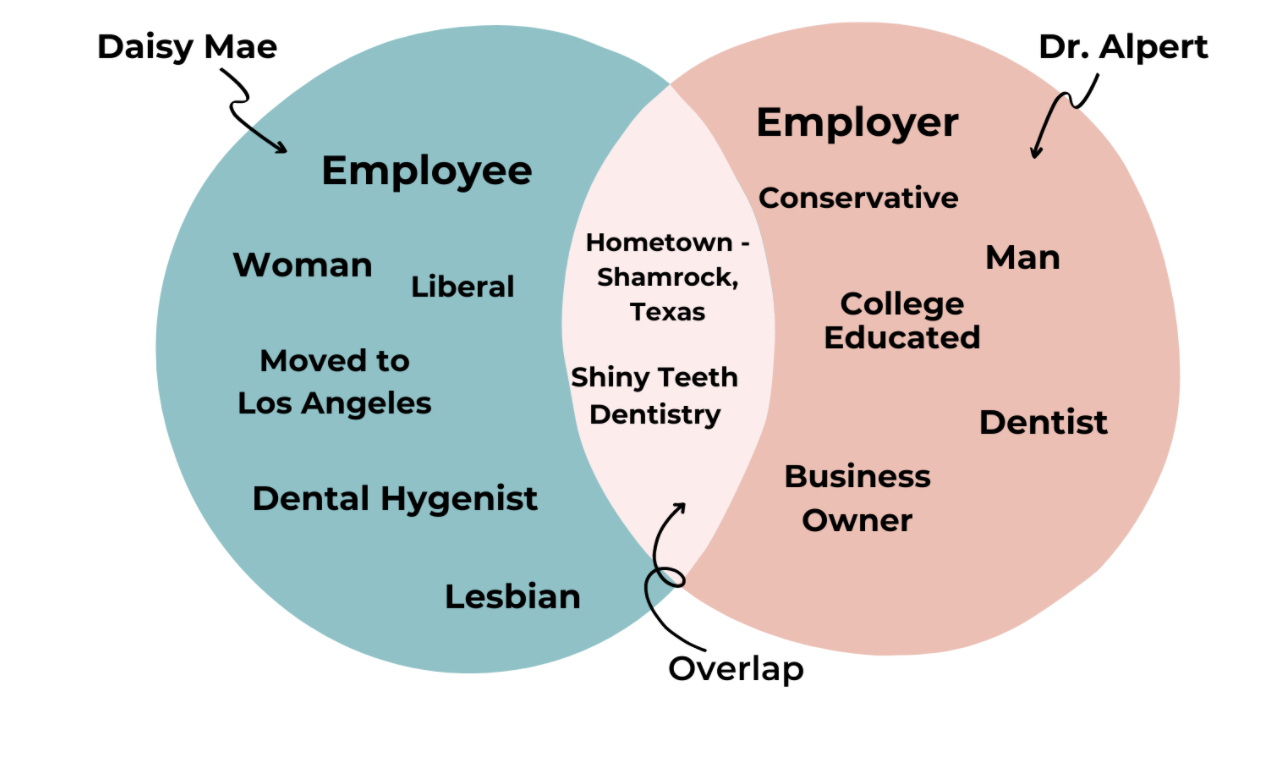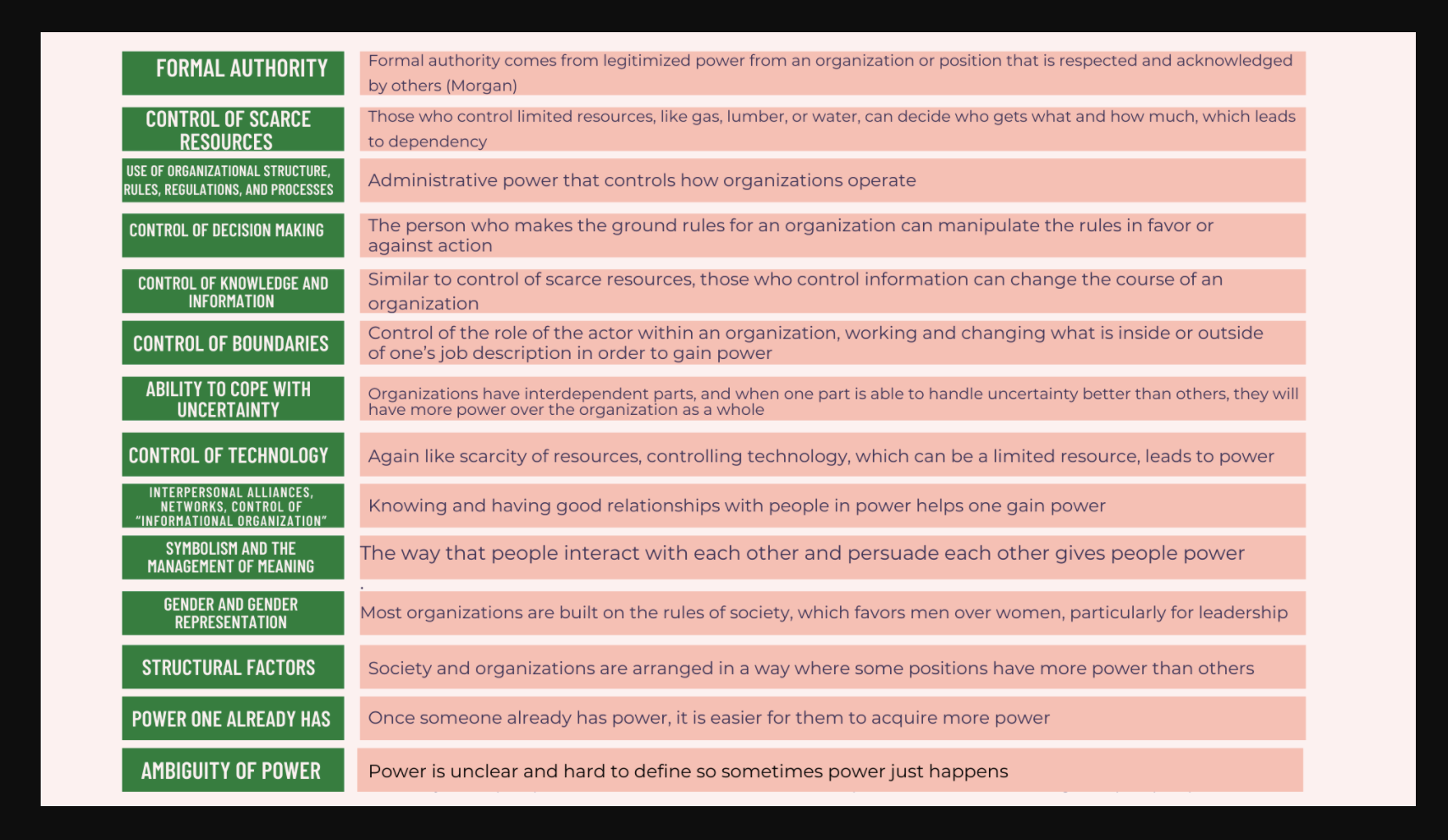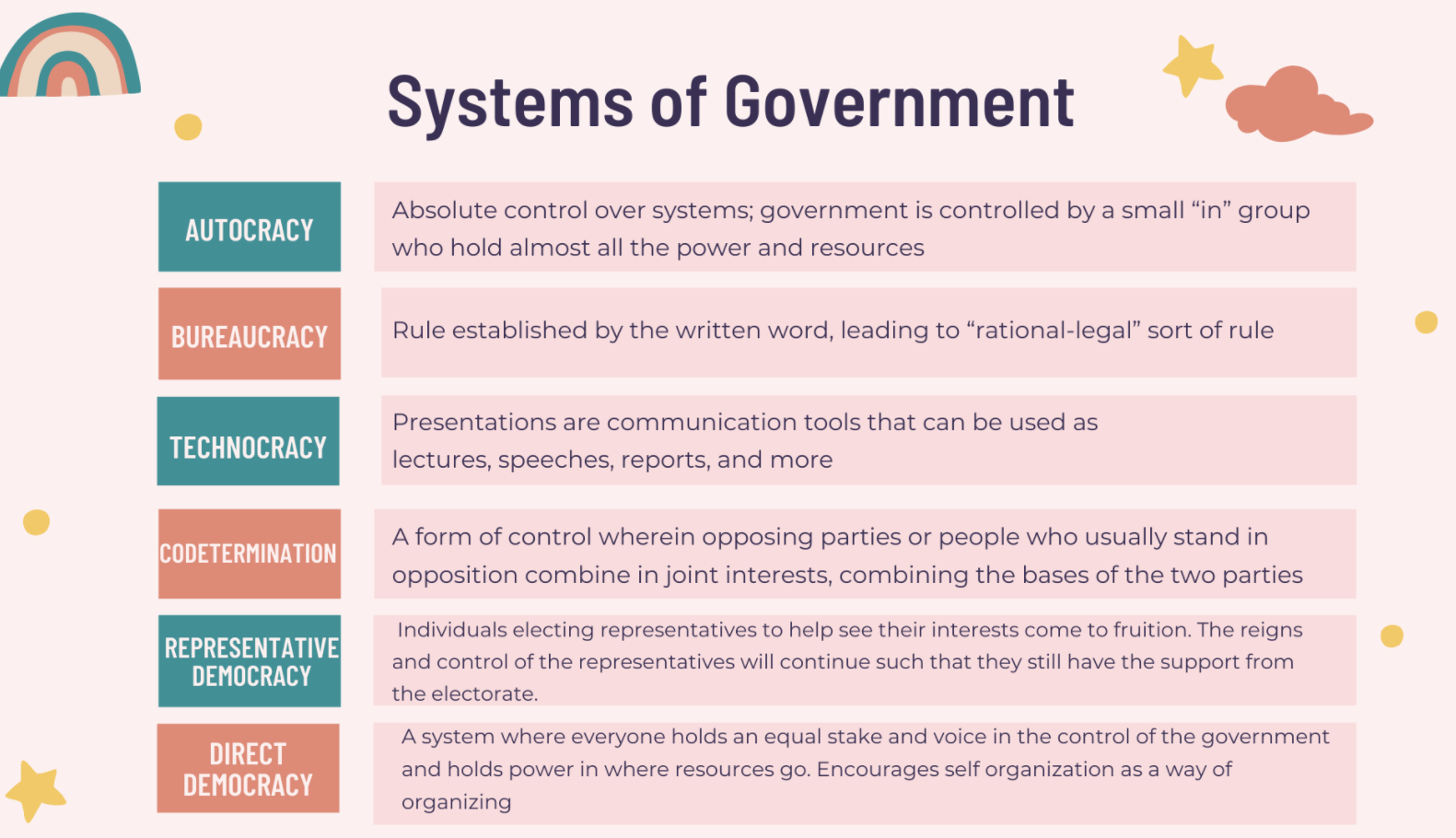3 organization as political system
Here is a case study to look at to understand what politics are and how politics function in organizations. Politics are important because they describe how people interact with each other and organizations. Politics are in our lives every day. While reading or listening to the case study, think about how the characters interact with each other and their surroundings.
The following case study is fiction and is meant to be an example of how politics work. The people and office are made up, taking place in a real town.
Click here to listen to our case study, or here to see a transcript of it

Now let’s understand what is happening and why. It was likely that the ideas of politics were not at the forefront of your mind in the above section, as you were likely focused on the exchange of ideas and views of two individuals. However, this is exactly how Aristotle classically defines politics: the interaction of divergent interests, and the coalitions built to remedy our differences “…Aristotle advocated politics as a means of reconciling the need for unity in the Greek polis (city-state) with the fact that the polis was an ‘aggregate of many members.’” (Morgan 150). This is not the only way that politics affects our lives, though, as the interactions between the multiple power structures that contrast with our own identities and interests also shape our organizational selves. This means that, no matter what we do, our actions are and will be political.
Politics become prevalent in an organization when resources are declining, workers lose trust in one another and the organization, or unclear evaluation systems or job specifications. The individual characteristics of others’ experiences can also affect the prevalence of politics in the workplace.
While they both grew up in the same town, Dr. Alpert’s upbringing encouraged him to stay and improve the town, whereas Daisy Mae’s made her leave and find acceptance elsewhere, due to who she loves being political. Although his political identity fits in better with the town around him, Dr. Alpert’s views about the world have certainly affected his work life and relationship with women. The construction of our lives are inherently political, and cannot be ignored when discussing how organizations are constructed.
Here are some questions to think about as we examine what is happening in our case study:
- How was it Daisy Mae’s political choice to move to Los Angeles after coming to her family?
- What did Daisy Mae and Joni have to compromise when wanting to build a family?
- In what ways is Dr. Alpert’s upbringing political? How do both of our character’s react differently to the politics of this small town
- What does Dr. Alpert’s small business signify within larger organizational structures?
- How does Dr. Alpert’s position of power influence Daisy Mae’s life?
- How can Daisy Mae escape organizational structures she can not control?
- How can Daisy Mae imagine new organizational structures?
Power
One of the key elements we wanted to highlight in our case study is the concept of power. In this section, we will discuss what power is, where it comes from, and how people use it in everyday life. Throughout this section think about these guiding questions from the case study.
- What did Daisy Mae and Joni have to compromise when wanting to build a family?
- How does Dr. Alpert’s position of power influence Daisy Mae’s life?

What is Power
Before defining power, it is important to think about what we already know about power. What are the powers in your life? Consider your conceptions of power. What comes to mind? What images are present? How do you view power? Is it something someone can have and/or hold? Is it an intangible force or does it have influence over others?
If you don’t have an answer… that’s okay. You might have a few answers, and, if you do, that’s okay too because no one definition has been agreed upon.
Morgan offers that “power is the medium through which conflicts of interest are ultimately resolved. Power influences who gets what, when, and how” (166)
He also suggests that “Power involves an ability to get another person to do something that he or she would not otherwise have done” (166).
Aristotle’s definition of power suggests that power is how people negotiate the world around them and find peace between different entities.
In simpler terms, power is the ability to influence or direct the behavior of others.
Where Does Power Come From
Power comes from a few different places. Let’s see where Morgan thinks power comes from.

Now think about the power that you have, and where it comes from.
How Do People/Organizations Get Power
To understand how people and organizations get power, we’re going to analyze our case study.
The two main characters are Daisy Mae and Dr. Alpert. Dr. Alpert has formal power, control of scarce resources, and control of decision making, as Daisy Mae’s boss. In this situation, he has power over her. Daisy Mae has power as an employee since Dr. Alpert’s office cannot run without its employees. He sets the boundaries of the office, the expectations of the work, and is relied on by his employees.
What are some other power dynamics in the case study?
Interests
We are now going to look at what interests are, who has interests, and how interests are seen in organizations. In this section think about these guiding questions from the case study:
- How was it Daisy Mae’s political choice to move to Los Angeles after coming to her family?
- What does Dr. Alpert’s small business signify within larger organizational structures?
Interests are what individuals want from others and organizations. Everyone who has any sort of stake in an organization has interests relating to that organization. This can be anyone from an employee to a manager, a shareholder to a customer and interests differ from people holding different roles within the organization.
How are interests worked out in organizations?

When different actors within organizations have diverging interests, conflict can arise. This conflict is usually settled by differences in power.
Sometimes, people with similar interests will come together to increase their power. They do this by building alliances or coalitions, usually with the goal to increase their communal leverage within the organization. One example of this kind of coalition building is workers unions. Workers unions often use their power to fight for higher wages or better working conditions. One common tactic is a strike, when all of the employees in the union decide to stop working, usually until their demands are met. In the case of a labor strike, the unionized workers use their knowledge of their manager’s interest (to have a working labor force) against them by depriving them of that need. Now, it is in the manager’s best interest to give their employees what they desire to meet their initial interest of having a working labor force. By lining up their manager’s interests with theirs, the labor strike works to have the union’s needs met.
What are the interests in this case study?
Everyone in the case study has individual interests, but the ones we will focus on are those of Daisy Mae and Dr. Alpert. When Daisy Mae asks for time off for maternity leave, her personal interests are to have time off so that she can safely carry her pregnancy to term and have time with her baby once they are born. She also wants partial pay throughout the time off so that she can continue to provide her family a steady income. She also does not want to be fired from her job. Dr. Alpert has a small workforce so his personal interest is to give Daisy Mae as little time off as possible as to not be short staffed for too long. These interests do not align, but because Daisy Mae has less power in this situation, she had no choice, but to take Dr. Alpert’s offer of shorter maternity leave or quit.
How are organizations political?
Everything that happens in an organization is political because in every interaction there are different interests, power dynamics, and political choices at play.
Differing Interests
Everyone within an organization has individual interests. The existence of divergent interests make organizations inherently political because conflict can arise when interests don’t align.
Power Dynamics and Bargaining
When conflict arises, power dynamics and bargaining come into play. This happens through political choices. In the earlier example, the union gained power as a result of the workers joining forces and aligning their common interests. By all employees going on strike at the same time, they were able to use their collective power to bargain for better working conditions. In this case, the workers had something that the management wanted (their ability to do work) and management had something that the workers wanted (the ability to give higher wages and improve the working conditions), so they bargained in order to meet everyone’s interests.
Political Choices

Every choice that someone makes in an organization is a political one. When someone chooses to work overtime, for example, they might be trying to make a deadline, impress their boss, or make more money. All of these are different interests, and the choice to work overtime is a way to advance those interests. However, this choice also has different drawbacks, such as spending less time with family and wearing the person down. The employee has to weigh the pros and cons to make an informed decision.
How is the dentist office political? In what ways is Dr. Alpert’s upbringing political? How do both of our character’s react differently to the politics of this small town?
The dentist office can be viewed as a political system for several reasons. First we can consider the power that each person holds. As the owner of the practice and Daisy Mae’s boss, Dr. Alpert has formal authority in this situation. However, as an employee of 5 years, Daisy Mae has been able to build rapport with Dr. Alpert, giving her some more informal power due to established trust.
In terms of interests, Daisy Mae has an interest in carrying her baby safely to term and having time with them after they are born, and to not lose her job. Meanwhile, Dr. Alpert has interest in keeping his practice open and fully staffed for as long as possible. It is also in Dr. Alpert’s interest to not have to hire and train a new hygienist. This means that he has an interest in meeting Daisy Mae’s needs so that she does not quit. Deciding on a shorter time for her maternity leave was a form of bargaining, only partially meeting each of their needs.
Daisy Mae and Dr. Alpert both had to make political choices throughout the case study. When Daisy Mae asked for 12 weeks off instead of 16, this was a political choice. She knew that Dr. Alpert had a history of denying these kinds of requests, so she specifically asked for something she thought he was more likely to accept. Dr. Alpert also made a political choice by offering a shorter amount of time than what Daisy Mae had asked for. There was an inherent risk to his self interest by doing this, that being that Daisy Mae might make the political choice to quit her job instead of taking his offer (or bargain). Political choices are embedded in our everyday interactions and can not be avoidable regardless of political power or authority.
Systems of Government
While the idea of politics may not always be linked to government, it is certainly how people view it contemporarily, and it seeps into how we view our organizational selves and surroundings. It is likely that people have a negative perception of government and the idea of “politics” as a whole because of how organizations commonly shape themselves. As Morgan describes, “The basis of day-to-day order in these organizations tends to be autocratic rather than democratic in that the ultimate power to shape action rests in the hands of a single individual or group, who typically makes all the important decisions.” The methods listed here can apply to multiple organizations as well. For example, if Dr. Alpert were to follow up the Daisy Mae case study by establishing policies around maternity leave, this would be a bureaucratic control of boundaries. There are many ways in which the seeking of interests leads to various types of government, not all of which distribute equal amounts of autonomy to all it’s actors’ interests.are created equal in terms of distributing equal amounts of autonomy to all its actors’ interests:

Strengths and Limitations of this Metaphor
Guided questions:
How can Daisy Mae escape organizational structures she can not control?
How can Daisy Mae imagine new structures?
How do the strengths make up for the other metaphors?
The strengths of the organization as a political system allow us to accept the reality of politics in an organization, and to overcome the limitations of other views that describe organizations as unified systems.
Viewing organizations as political systems help shed some light on power structures that are not made obvious by either domination or psychic prisons. Domination and psychic prisons both have a very linear view on power; people at the top have it and those at the bottom do not. However, when we view power in the context of political systems, we can see that power comes from many different places and can be held at all levels of the organization. Even those outside of an organization can hold power, such as customers who might decide to boycott a certain brand, product, or service.
How are the weaknesses made up for in the other metaphors?
The limitations of viewing organizations as political systems include a possible overstatement of the power and the importance of the individual, and potentially misses the more systemic factors at play in the organization. This view also leads to an increased politicization of the organization, which can cause mistrust and cynicism. Other metaphors such as domination can show how power impacts the whole system rather than just the individual.
This chapter was re-written by Aviva V. Maxon, Matthew Gainsboro, Claire Partridge, and Jessica Sass. The original work was written by Aloha Cerit, Lauren Kim, and Hannah Lewis.
Sources:
French, John R P, and Bertram Raven. (1959). “The Bases of Social Power,” 259-269.
Morgan, G. (1997). “Chapter 6: Interests, Conflicts, and Power,” 149-206.
